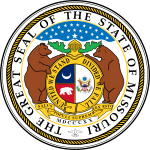| ||||||||||||||||||||||||||||
17 odd-numbered districts in the Missouri Senate 18 seats needed for a majority | ||||||||||||||||||||||||||||
|---|---|---|---|---|---|---|---|---|---|---|---|---|---|---|---|---|---|---|---|---|---|---|---|---|---|---|---|---|
| ||||||||||||||||||||||||||||
 Results Republican gain Democratic gain Republican hold Democratic hold No election | ||||||||||||||||||||||||||||
| ||||||||||||||||||||||||||||
| Elections in Missouri |
|---|
 |
The 2024 Missouri Senate election took place on Tuesday, November 5, 2024, with the primary election held on Tuesday, August 6, 2024.[1][2] Missouri voters elected state senators in the 17 odd-numbered districts of the Senate to serve four-year terms.[3]
The election coincided with United States national elections and Missouri state elections, including U.S. President, U.S. Senate, U.S. House, Governor, and Missouri House.[4]
Following the previous election in 2022, Republicans held a 24-to-10-seat supermajority over Democrats.[5] Going into the 2024 elections, there are four vacancies after Senator Greg Razer (D) of District 7 resigned on April 25, 2024, Senators Karla Eslinger (R) of District 33 and John Rizzo (D) of District 11 resigned in June 2024, and Lauren Arthur (D) of District 17 resigned in July 2024.[6][7][8][9] Therefore, there are 23 Republicans and seven Democrats at the time of the 2024 election (plus the three vacancies). Democrats would have to net 11 seats to flip control of the chamber.[1]
These will be the first elections in the odd-numbered Missouri Senate districts following the 2020 United States redistricting cycle, which resulted in redrawn legislative district boundaries.[10][11]
- ^ a b "Missouri State Senate elections, 2024". Ballotpedia. Retrieved June 20, 2024.
- ^ "2024 State Primary Election Dates and Filing Deadlines". National Conference of State Legislatures. Retrieved June 20, 2024.
- ^ "Missouri Senate". Missouri General Assembly. Retrieved June 20, 2024.
- ^ "Missouri Election Results". Missouri Secretary of State. Retrieved June 20, 2024.
- ^ "Missouri State Senate elections, 2022". Ballotpedia. Retrieved June 20, 2024.
- ^ Cite error: The named reference
RazerVACwas invoked but never defined (see the help page). - ^ Cite error: The named reference
EslingerVACwas invoked but never defined (see the help page). - ^ Cite error: The named reference
RizzoVACwas invoked but never defined (see the help page). - ^ Cite error: The named reference
ArthurVACwas invoked but never defined (see the help page). - ^ "Final Redistricting Maps". Missouri Secretary of State. Retrieved June 14, 2024.
- ^ "Statewide Senate Map" (PDF). Missouri Secretary of State. Retrieved June 19, 2024.

